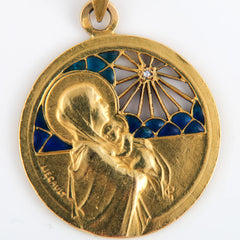
What is plique-à-jour enamel?
Everything you need to know about the plique-à-jour enamel technique
The essentials on this plique-à-jour enamel technique
“Plique-à-jour” enamel is a complex enamelling technique used in the decorative arts, particularly during the Art Nouveau period, but today almost abandoned due to its cost and the scarcity of art artisans. mastering this technique.
The term "plique-à-jour" comes from the French words "pliquer", meaning "to fill", and "jour", meaning "daylight" or "opening". This technique consists of creating patterns using transparent or translucent enamels applied to a metal frame, generally gold, silver or in other precious metals, therefore without a bottom (unlike the cloisonné or champlevé technique). After firing, the enamel only attaches to the partitions, which allows this transparency, like a church stained glass effect.
Some characteristics of the plique-à-jour enamel technique
- Translucent effect: Plique-à-jour enamel is known for its translucent or tinted glass appearance. The enamel is applied into delicate cells or compartments and, when viewed against the light, allows light to pass through, creating a beautiful, opalescent effect.
- Formation of the cells: The metal frame of the piece is meticulously worked to form cells or partitions which retain the enamel. These cells are often created by welding or forming thin metal wires, which allows complex patterns to be obtained, or by cutting them out of a metal plate.
- Application of the enamel: The enamel, a glass powder, is carefully placed in the cells of the metal frame. The piece is then fired in a high temperature kiln, which allows the enamel to melt and fuse with the metal. Multiple coats of enamel can be applied and fired to achieve the desired color and depth.
- Difficult technique: Paste-a-day enamelling is considered one of the most difficult enamelling techniques due to its complexity and the risk of cracking of the enamel or alteration of the color of the enamel. E-mail.

History and art masters of the plique-à-jour technique
We certainly find enamel work in antiquity around the 2nd century BC, but plique-à-jour appears rather during the Byzantine Empire, around the 4th century AD. It is found later in Europe in the Middle Ages. -Age. Limoges was already an important center of enamel know-how during this period. We find traces of the description of this process in the 16th century by Benvenuto Cellini. However, it is extremely rare to find pieces from these periods given their fragility.
In the 19th century, Alexis Falize, like Jules Chaize, Eugène Fontenay, Froment-Meurice, Frédéric Boucheron, rediscover these enamels and their artisans. Around 1864, the enameler Charles Riffault produced plique-à-jour enamel pieces for Boucheron, presented at the Universal Exhibition in Paris.
Rein Lalique was one of those who used this material the most among the representatives of Art Nouveau who also Fabergé and Vever…
Today, Sandrine Tessier, French, best worker in France, works with Vever and Inès Hamaguchi, Swiss, with great goldsmiths like Cartier or Hermès, are among the names that reference the plique-à-jour enamel technique to create exceptional pieces.
You will find enamel jewelry and some in plique-à-jour, particularly in our selection of jewelry Art Nouveau.
